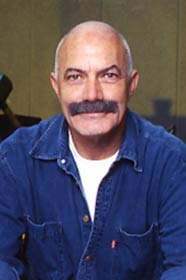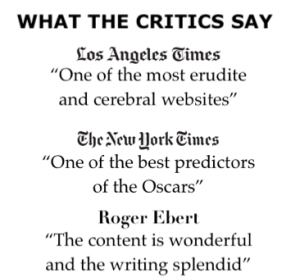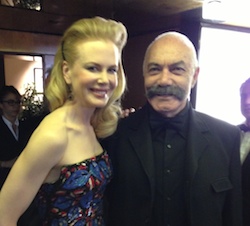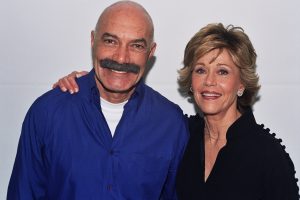Fritz Lang directed Scarlet Street, a film noir about two criminals who exploit a middle-aged painter in order to steal his artwork.

Scarlet Street COURTESY EVERETT COLLECTION
Edward G. Robinson, Joan Bennett and Dan Duryea had all earlier appeared in Lang’s The Woman in the Window, so comparisons between the two films were inevitable.
Robinson plays Christopher “Chris” Cross, an amateur painter and cashier for a clothing retailer, who in the first scene is honored for his long years of service. The company head J.J. Hogarth gives Chris a gold watch, then leaves the party with a beautiful young blonde, while Chris is musing about his desire to be loved.
Grade: B (**** out of *****)
| Scarlet Street | |
|---|---|
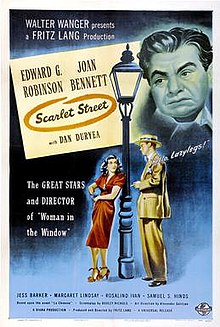
theatrical release poster
|
|
One night, walking home through Greenwich Village, Chris saves Katherine “Kitty” March (Joan Bennett), when she is being seemingly attacked. Unaware that the attacker is Johnny (Dan Duryea), Kitty’s boyfriend, Chris calls a policeman, but Johnny manages to flee.
Chris walks Kitty to her apartment, and she accepts his offer to join him for coffee at a nearby bar. Chris’s comments lead Kitty to mistakenly believe that he’s a wealthy painter.
Meanwhile, we learn that Chris is stuck in loveless marriage with shrewish wife Adele (Rosalind Ivan), who still idolizes her previous husband, a cop believed to have been drowned in the East River while trying to rescue a suicidal woman.
When Chris confesses that he is married, and Johnny convinces Kitty to feign romantic interest in Chris in order to swindle his money.
Chris rents Kitty her an apartment which doubles as his art studio. To finance the apartment, Chris steals $500 in insurance bonds from his wife and $1000 cash from his employer.
Unknown to Chris, Johnny tries selling his paintings, leaving them with a Greenwich village street vendor who thinks they are worth no more than $25. They unexpectedly attract the interest of art critic David Janeway (Jess Barker), who thinks they are exceptional art.
After Johnny persuades Kitty to pretend that she painted them, she charms Janeway with Chris’s own descriptions of his art. Captivated by the paintings and Kitty, Janeway promises to represent her. However, Adele sees her husband’s paintings—signed “Katherine March”—for sale in the window of a commercial art gallery and accuses Chris of copying March’s work.
Chris confronts Kitty, who claims she had sold them because she needed the money. He is so delighted that his paintings are appreciated, albeit under a ruse, that he happily lets her become the public face of his art. She becomes a huge commercial success, although Chris never gets any of the money.
Adele’s supposedly dead husband, Higgins (Charles Kemper), suddenly reappears at Chris’s office to extort money from him. He explains that he did not drown but disappeared after stealing $2,700 from the purse of the suicidal woman he tried to save. Already suspected of taking bribes from speakeasies, he faked his death to escape his crimes and his wife.
Chris lets Higgins into Adele’s room—ostensibly to pilfer the insurance money Adele received after his supposed death—aware she is asleep in the room; Chris assumes that his marriage will be invalidated when his wife sees her first husband is still alive.
Chris goes to see Kitty, believing he is now free to marry her. Instead, he finds Johnny and Kitty embrace, confirming his suspicions that they are romantically involved. Believing her infatuation with Johnny is fleeting, Chris asks Kitty to marry him; she spurns him for being old and ugly and laughs in his face. Enraged, he stabs her to death with an ice pick.
The police visit Chris for embezzling money from his employer. Although his boss refuses to press charges, Chris is fired. And Johnny is arrested for Kitty’s murder.
At the trial, Johnny’s hustling and deception work against him. Despite his attempt to implicate Chris in Kitty’s murder, Chris denies painting the pictures, claiming to be an untalented artist. Several witnesses confirm Chris’s testimony and attest to Johnny’s misdeeds and bad character.
Johnny is convicted and put to death for Kitty’s murder, Chris goes unpunished, and Kitty is erroneously recognized as a great artist.
Haunted by the murder, Chris attempts to hang himself. Though rescued, he becomes tormented by memories of Kitty and Johnny, hearing their voices in his mind.
In the bleak ending, Chris is reduced to a ghost, a homeless and destitute man, wandering aimlessly the streets of New York.
The film was based on the French novel “La Chienne” by Georges de La Fouchardière, which had been filmed as La Chienne (1931) by director Jean Renoir.
Lang’s 1954 film Human Desire was a remake of another Renoir film La Bête Humaine (1938), which was based on Émile Zola’s novel
Scarlet Street bears resemblance to The Woman in the Window in themes, cast, crew and characters. In both films, Robinson plays a lonely middle-aged man, and Bennett and Duryea play the villainous criminals.
Both films were shot by ace photographer Milton R. Krasner.
Walter Wanger had earlier produced Lang’s 1937 film You Only Live Once.
Credibility Issue:
It is nice to see Dan Durea, usually just the heavy villain, play Bennett’s lover–she claims repeatedly that she is in love with him. However, there is no chemistry between the two, and it’s hard to believe that a woman of her beauty and stature would fall for a guy like Durea.
Critical Response in 1945:
Variety magazine stated: “Lang’s production and direction ably project the sordid tale of the romance between a milquetoast character and a gold-digging blonde … Edward G. Robinson is the mild cashier and amateur painter whose love for Joan Bennett leads him to embezzlement, murder and disgrace. Two stars turn in top work to keep the interest high, and Dan Duryea’s portrayal of the crafty and crooked opportunist whom Bennett loves is a standout in furthering the melodrama.”
By contrast, Time magazine gave Scarlet Street a negative review, describing the plot as clichéd and with dimwitted, unethical, stock characters.
Commercial Success
Though it divided critics, the film was a commercial success, more popular than other Lang films of that decade; it earned $2.5 million in rentals in the U.S.
More importantly, it resurrected the careers of the artists involved, in front and behind the camera, though Robinson later went on record, claiming that he disliked making both Lang films.
Censorship Issues:
In the course of the film, Joan Bennett is repeatedly slapped across the face by Dan Dureya. By today’s standards, it would be considered a case of serious and vicious abuse.
Local authorities in some cities had banned the showing of Scarlet Street because of its dark plot and themes.
“The picture is a morbid, seamy story dealing with the dregs of humanity,” wrote Terry Ramsaye, editor of Motion Picture Herald, in 1946.
Lang’s Scarlet Street had slipped by the Breen office to incite the wrath of mainstream critics and municipal censors. “One of these abominations now and then may be accepted in the flow of entertainment offerings,” Ramsaye notes, but “a cycle of the like would be disastrous.”
Cast
Edward G. Robinson as Christopher Cross
Joan Bennett as Katherine ‘Kitty’ March
Dan Duryea as Johnny Prince
Margaret Lindsay as Millie Ray
Rosalind Ivan as Adele Cross
Jess Barker as David Janeway
Charles Kemper as Patch-eye Higgins
Anita Sharp-Bolster as Mrs. Michaels
Samuel S. Hinds as Charles Pringle
Vladimir Sokoloff as Pop LeJon
Arthur Loft as Dellarowe
Russell Hicks as J.J. Hogarth
Credits:
Directed by Fritz Lang
Screenplay by Dudley Nichols, based on La Chienne, 1931 novel and play by Georges de La Fouchardière (novel) and André Mouézy-Éon (play)
Produced by Walter Wanger
Cinematography Milton R. Krasner
Edited by Arthur Hilton
Music by Hans J. Salter
Production companies: Walter Wanger Productions, Fritz Lang Productions, Diana Production Company
Distributed by Universal Pictures
Release date: December 28, 1945 (US)
Running time: 102 minutes
Budget $1,202,007
Box office $2,948,386





